How to Start
Once you’ve defined both your overall strategy, your purpose and your voice, it’s time to get tactical.
Target Your Conversations
Finding a place for your conversations requires that you first locate where those you want to communicate with currently are. Start by searching the top 10 Social Media networks outlined in the first post in this series and look for likely audiences. If you are B2B, LinkedIn is a great place to start for example. Get a lay of the land within each community you are considering. Notice the segments, the conversations, where your competitors are and where they are not.
Define Your Voice
Decide which conversational voice you will adopt (See Define Your Voice). Once you’ve decided on which ‘personality’ best represents your company, this makes it easier to find the person who will actually be writing the Social Media content. Try and match the content provider’s personality with your chosen voice.
Start Slow
Nobody jumps on the Social Media freeway going 120 MPH immediately. It takes time to get up to that speed. Use the ramp up period to refine your message, learn what gets read, what triggers other conversations. You may in fact have no choice but to start slow. Few new bloggers are recognized as overnight visionaries.
Stay Consistent
You may find that 3-6 months into it you are still not seeing the kinds of results you were expecting. Be patient and whatever you do, stay the course. Watch your subscription rates as they slowly rise. You’ll typically see a lift each time you post. But watch the unsubscribe rates as well, particularly after posts. If they spike, review your content and make sure it is still relevant to your audience.
Remember That Most Readers Are Laying on the Sand. You may go months without a single comment to your incredibly well articulated posts. Just remember most readers will never post a comment. Instead make sure you post comments regularly on other blogs. Use your voice to respond to everything. Get heard, get noticed via comments. It will help drive traffic back to your posts. Readers will start to recognize you.
Acknowledge the Quick Wins
Someone read your post about an upcoming webinar and sent it to a colleague, which resulted in 2 new registrations. Make sure you document these quick wins and announce them to the team. These quick wins, as small as they may be, continue the momentum and lets everyone know their efforts are paying off – even if it’s one registration at a time.
Recognize that we are all Pioneers
Marketing’s embrace of Social Media is still in its infancy, despite all the hoopla. Things will change, new communities will be born or reshaped or go extinct. Just when you’ve got it all figured out, the rules will change (think SEO). Be agile, be patient, embrace change and commit to staying the course.
Part 1-Social Media: An Executive Primer
Part 2-Define Your Strategy
Part 3-Define Your Purpose
Part 4-Define Your Voice
Part 5-Audience Relationships
Part 6-How to Start
Part 7-Measuring Success
Part 8-Social Media Do’s and Don’ts
Updated 5-8-12
Visit my brand new website and learn more about Social Media Marketing Best Practices
Steve Kellogg
-Demand Generation/Marketing Automation Consultant, Astadia
-Eloqua Certified Marketing Best Practices Consultant
Thursday, December 31, 2009
Wednesday, December 30, 2009
Social Media Executive Primer Part 5
Audience Relationships
As with all marketing, the focus of Social Media is to build (and even repair) relationships. The key to driving a successful relationship is relevance. If your content isn’t of much interest to a reader, it is doubtful you will ever be able to build a relationship with that person.
Remember your goal is to create raving fans. And not only that, but to create raving fans that actually rave about you. With 97% of social media readers laying on the sand and only 3% actually in the water, you begin to see the kind of numbers game you’ll have to play to get others to rave about you.
And in order to do that, you have to communicate about something that your target audience is completely passionate about. The good news is that Social Media encompasses an enormous number of very detailed segments that you can tap into. The more specific the segment the better your chances at building a lasting, raving fan relationship.
It will obviously require more dedicated resources to create the many different segmented conversations you’ll likely identify. Batch and Blast has no place in social media, or anywhere else for that matter. Choose niches that convert, then go after everyone else. It is better to go after a group of 20 swimmers than 20,000 sunbathers.
If you currently use marketing automation tools, another way to build the relationship is to get your readers into your database so you can add them to your nurturing/scoring programs. Don’t think social media replaces email. In fact, a recent Nielsen Company analysis found that the heaviest social media users actually use email more, perhaps because of the steady stream of messages that social networks dump into participants’ inboxes.
Whichever voice you choose, know that the conversation will have to be passionate, dedicated, consistent and even intimate if you want real results. Just remember, your conversations are always about what you can do for your reader, it’s never about what they can do for you.
Your conversations are real-time examples of your brand. Build raving fans and let them disseminate your brand for you.
Part 1-Social Media: An Executive Primer
Part 2-Define Your Strategy
Part 3-Define Your Purpose
Part 4-Define Your Voice
Part 5-Audience Relationships
Part 6-How to Start
Part 7-Measuring Success
Part 8-Social Media Do’s and Don’ts
Updated 5-8-12
Visit my brand new website and learn more about Social Media Marketing Best Practices
Steve Kellogg
-Demand Generation/Marketing Automation Consultant, Astadia
-Eloqua Certified Marketing Best Practices Consultant
As with all marketing, the focus of Social Media is to build (and even repair) relationships. The key to driving a successful relationship is relevance. If your content isn’t of much interest to a reader, it is doubtful you will ever be able to build a relationship with that person.
Remember your goal is to create raving fans. And not only that, but to create raving fans that actually rave about you. With 97% of social media readers laying on the sand and only 3% actually in the water, you begin to see the kind of numbers game you’ll have to play to get others to rave about you.
And in order to do that, you have to communicate about something that your target audience is completely passionate about. The good news is that Social Media encompasses an enormous number of very detailed segments that you can tap into. The more specific the segment the better your chances at building a lasting, raving fan relationship.
It will obviously require more dedicated resources to create the many different segmented conversations you’ll likely identify. Batch and Blast has no place in social media, or anywhere else for that matter. Choose niches that convert, then go after everyone else. It is better to go after a group of 20 swimmers than 20,000 sunbathers.
If you currently use marketing automation tools, another way to build the relationship is to get your readers into your database so you can add them to your nurturing/scoring programs. Don’t think social media replaces email. In fact, a recent Nielsen Company analysis found that the heaviest social media users actually use email more, perhaps because of the steady stream of messages that social networks dump into participants’ inboxes.
Whichever voice you choose, know that the conversation will have to be passionate, dedicated, consistent and even intimate if you want real results. Just remember, your conversations are always about what you can do for your reader, it’s never about what they can do for you.
Your conversations are real-time examples of your brand. Build raving fans and let them disseminate your brand for you.
Part 1-Social Media: An Executive Primer
Part 2-Define Your Strategy
Part 3-Define Your Purpose
Part 4-Define Your Voice
Part 5-Audience Relationships
Part 6-How to Start
Part 7-Measuring Success
Part 8-Social Media Do’s and Don’ts
Updated 5-8-12
Visit my brand new website and learn more about Social Media Marketing Best Practices
Steve Kellogg
-Demand Generation/Marketing Automation Consultant, Astadia
-Eloqua Certified Marketing Best Practices Consultant
Tuesday, December 29, 2009
Social Media Executive Primer Part 4
Define Your Voice
Once you’ve established your purpose, the next step is to define your voice.
Below are the most effective types of voices to use. Begin by taking a subjective look at your company’s persona. How do you currently communicate to your customers. Are you light and endearing? Corporate and slightly pretentious? Steadfast and reliable? Choose the personality that best fits your company culture.
Whichever voice you choose, stick with it; don’t change voices mid-stream. Don’t change what makes you – you. This will only confuse your readers. Consistency is key, no matter which voice you adopt.
Reactionary
Nothing drives traffic like a good rant. One look at reality TV and you see those with the loudest voices tend to have the highest ratings. But if you use this method, don’t just scream about the problem. Be prepared to provide a solution. This method taps into common frustrations your target market is likely having with other solutions, or the challenges with a lack of any solution. The communication sequence is usually (1) connect with the problem (2) acknowledge the pain (3) provide empathy (4) reiterate what will happen if nothing is done (5) offer your solution.
Exclusivity
Find something that few people are offering solutions for. Or offer unique solutions to common problems.
Take an inventory of your IP and see where you can share those things that make you unique. This method works best if you are offering something truly scarce. Specific niches where you’ve created a custom solution for example. Play up the fact that your content is extremely valuable, that it is not something shared to many or made public. Make your audience feel like they’ve hit the jackpot with your content.
Thought Leadership
Much of today’s social media revolves around thought leadership. It’s the best type of conversation to have with anyone just beginning their buyer journey. This combined with Exclusivity provides a powerful positioning statement. While some people balk at the idea of divulging their inner most secrets, today’s best webinars provide a good roadmap of how to provide thought leadership that encourages follow up dialog. The main goal is to prove your credibility. The more segmented you can make your communications the better. Your content must appear at the right time to the right person with the right message. General Thought Leadership will only get you so far and usually won’t get your name on a short list. Include both strategic and tactical communications in your thought leadership mix.
Reliability
Seth Godin delivers a blog every single day, 7 days a week, rain or shine. Whether you choose to add content once a day, once a week or once a month, once you commit to a schedule, stick to it. Don’t deviate, don’t change the pattern. Consistency is key. Frequency is usually driven by bandwidth. If your contributors have the time to contribute MEANINGFUL dialog each day, great. Deliver whatever you can realistically consistently manage. Don’t make the mistake of delivering daily just to deliver daily. Your content must always be meaningful, useful and worth the time and effort of your readers.
Agreement
Politicians are masters at getting agreement. Identifying and acknowledging a problem lends itself to getting buy-in and agreement with your particular solution. The more relevant you can articulate the exact problem, the more agreement you are likely to get. This ties into a Reactionary voice very well. By virtue of you acknowledging the frustration of the problem you are discussing, agreement comes much more naturally. But don’t try and gain agreement on the obvious. Prove that you really have gone through the same specific ordeals your readers have.
Share the Love
Making friends is often a good way to engage in Social Media. Be prepared to do something for someone ‘just because’. Be genuine and never feign your intentions. Expect nothing in return. This might be a good method of communicating to current customers. Whether up selling, cross-selling or working towards subscription renewals, this type of communication is all about serving others. Almost philanthropic. The end result – creating not just a loyal customer but raving fans.
Part 1-Social Media: An Executive Primer
Part 2-Define Your Strategy
Part 3-Define Your Purpose
Part 4-Define Your Voice
Part 5-Audience Relationships
Part 6-How to Start
Part 7-Measuring Success
Part 8-Social Media Do’s and Don’ts
Updated 5-8-12
Visit my brand new website and learn more about Social Media Marketing Best Practices
Steve Kellogg
-Demand Generation/Marketing Automation Consultant, Astadia
-Eloqua Certified Marketing Best Practices Consultant
Once you’ve established your purpose, the next step is to define your voice.
Below are the most effective types of voices to use. Begin by taking a subjective look at your company’s persona. How do you currently communicate to your customers. Are you light and endearing? Corporate and slightly pretentious? Steadfast and reliable? Choose the personality that best fits your company culture.
Whichever voice you choose, stick with it; don’t change voices mid-stream. Don’t change what makes you – you. This will only confuse your readers. Consistency is key, no matter which voice you adopt.
Reactionary
Nothing drives traffic like a good rant. One look at reality TV and you see those with the loudest voices tend to have the highest ratings. But if you use this method, don’t just scream about the problem. Be prepared to provide a solution. This method taps into common frustrations your target market is likely having with other solutions, or the challenges with a lack of any solution. The communication sequence is usually (1) connect with the problem (2) acknowledge the pain (3) provide empathy (4) reiterate what will happen if nothing is done (5) offer your solution.
Exclusivity
Find something that few people are offering solutions for. Or offer unique solutions to common problems.
Take an inventory of your IP and see where you can share those things that make you unique. This method works best if you are offering something truly scarce. Specific niches where you’ve created a custom solution for example. Play up the fact that your content is extremely valuable, that it is not something shared to many or made public. Make your audience feel like they’ve hit the jackpot with your content.
Thought Leadership
Much of today’s social media revolves around thought leadership. It’s the best type of conversation to have with anyone just beginning their buyer journey. This combined with Exclusivity provides a powerful positioning statement. While some people balk at the idea of divulging their inner most secrets, today’s best webinars provide a good roadmap of how to provide thought leadership that encourages follow up dialog. The main goal is to prove your credibility. The more segmented you can make your communications the better. Your content must appear at the right time to the right person with the right message. General Thought Leadership will only get you so far and usually won’t get your name on a short list. Include both strategic and tactical communications in your thought leadership mix.
Reliability
Seth Godin delivers a blog every single day, 7 days a week, rain or shine. Whether you choose to add content once a day, once a week or once a month, once you commit to a schedule, stick to it. Don’t deviate, don’t change the pattern. Consistency is key. Frequency is usually driven by bandwidth. If your contributors have the time to contribute MEANINGFUL dialog each day, great. Deliver whatever you can realistically consistently manage. Don’t make the mistake of delivering daily just to deliver daily. Your content must always be meaningful, useful and worth the time and effort of your readers.
Agreement
Politicians are masters at getting agreement. Identifying and acknowledging a problem lends itself to getting buy-in and agreement with your particular solution. The more relevant you can articulate the exact problem, the more agreement you are likely to get. This ties into a Reactionary voice very well. By virtue of you acknowledging the frustration of the problem you are discussing, agreement comes much more naturally. But don’t try and gain agreement on the obvious. Prove that you really have gone through the same specific ordeals your readers have.
Share the Love
Making friends is often a good way to engage in Social Media. Be prepared to do something for someone ‘just because’. Be genuine and never feign your intentions. Expect nothing in return. This might be a good method of communicating to current customers. Whether up selling, cross-selling or working towards subscription renewals, this type of communication is all about serving others. Almost philanthropic. The end result – creating not just a loyal customer but raving fans.
Part 1-Social Media: An Executive Primer
Part 2-Define Your Strategy
Part 3-Define Your Purpose
Part 4-Define Your Voice
Part 5-Audience Relationships
Part 6-How to Start
Part 7-Measuring Success
Part 8-Social Media Do’s and Don’ts
Updated 5-8-12
Visit my brand new website and learn more about Social Media Marketing Best Practices
Steve Kellogg
-Demand Generation/Marketing Automation Consultant, Astadia
-Eloqua Certified Marketing Best Practices Consultant
Sunday, December 27, 2009
Social Media Executive Primer Part 3
Define Your Purpose
There are various purposes for social media marketing. Some marketers want to spark a movement while others simply want to use it to support other marketing efforts. It is important to decide what your purpose is in the social media world. Knowing your purpose will help align your strategies.
1. Be a Watch Dog. You can listen to what is being said about your business via social media marketing and use it as a way to police your brand. You might read a negative Tweet about your Customer Service Department and warn them so they can take the appropriate action to resolve the issue. Comcast has excelled at this.
2. Create a Conversation. One of the greatest benefits of social media marketing is it allows you to create a dialog with your customers, partners, prospects, colleagues, etc. The dialog is what builds the relationship and can allow you to benefit from it. The more conversations you have with your customers and prospects, the better you get to know them and their needs – and the better they get to know you and your business. And it can improve your relationship with them if done correctly because they will feel as though you are listening which is vital in any relationship. Use the dialog to do market research, respond quickly when issues arise, build your brand, and more!
3. Ignite a Movement. Some marketers use social media marketing to spark a movement meaning do something profound online that’s highly recognized and that others follow. For instance, Comcast staring using Twitter in 2008 by creating a “ComcastCares” account to target complaints about their services. It then responded to those complaints and worked toward a resolution for each and doing so, improved its customer service. Comcast has been recognized as one of the best companies at utilizing Twitter for B to C interactions. If you have something like this in mind, plan carefully because you may very well lose control once the movement is sparked.
4. Support Other Marketing Efforts. One of the most common purposes for engaging in social media marketing is to use it to support your other marketing efforts. Social media marketing is just another avenue to reach your target, create conversations, build and monitor your brand. If you have an event you want to promote, you can use traditional marketing avenues to promote it such as email, direct mail, banner ads, your website but you can also use social media marketing. It is one of thee cheapest marketing avenues if not thee cheapest. Most social media sites do not charge any fees so why not use them to promote your event? Just keep in mind the target audience for your event and be sure you don’t invite all your Facebook fans if you really only are targeting a small subset of them.
5. Innovate. Some marketers are finding ways to use social media to position themselves as thought leaders and innovators. Social media is, in itself, state-of-the-art marketing and a modern way of communicating so if you can use it to position your leaders and products as innovate, you gain double-time. Not only will your customers and prospects learn about your leaders and products but they will via a means they prefer and that’s most convenient for them such as on their Facebook or Twitter homepage or RSS feed. If you don’t reach out to them via social media, you can bet your competitors are!
Part 1-Social Media: An Executive Primer
Part 2-Define Your Strategy
Part 3-Define Your Purpose
Part 4-Define Your Voice
Part 5-Audience Relationships
Part 6-How to Start
Part 7-Measuring Success
Part 8-Social Media Do’s and Don’ts
Steve Kellogg
-Demand Generation/Marketing Automation Consultant, Astadia
-Eloqua Certified Marketing Best Practices Consultant
There are various purposes for social media marketing. Some marketers want to spark a movement while others simply want to use it to support other marketing efforts. It is important to decide what your purpose is in the social media world. Knowing your purpose will help align your strategies.
1. Be a Watch Dog. You can listen to what is being said about your business via social media marketing and use it as a way to police your brand. You might read a negative Tweet about your Customer Service Department and warn them so they can take the appropriate action to resolve the issue. Comcast has excelled at this.
2. Create a Conversation. One of the greatest benefits of social media marketing is it allows you to create a dialog with your customers, partners, prospects, colleagues, etc. The dialog is what builds the relationship and can allow you to benefit from it. The more conversations you have with your customers and prospects, the better you get to know them and their needs – and the better they get to know you and your business. And it can improve your relationship with them if done correctly because they will feel as though you are listening which is vital in any relationship. Use the dialog to do market research, respond quickly when issues arise, build your brand, and more!
3. Ignite a Movement. Some marketers use social media marketing to spark a movement meaning do something profound online that’s highly recognized and that others follow. For instance, Comcast staring using Twitter in 2008 by creating a “ComcastCares” account to target complaints about their services. It then responded to those complaints and worked toward a resolution for each and doing so, improved its customer service. Comcast has been recognized as one of the best companies at utilizing Twitter for B to C interactions. If you have something like this in mind, plan carefully because you may very well lose control once the movement is sparked.
4. Support Other Marketing Efforts. One of the most common purposes for engaging in social media marketing is to use it to support your other marketing efforts. Social media marketing is just another avenue to reach your target, create conversations, build and monitor your brand. If you have an event you want to promote, you can use traditional marketing avenues to promote it such as email, direct mail, banner ads, your website but you can also use social media marketing. It is one of thee cheapest marketing avenues if not thee cheapest. Most social media sites do not charge any fees so why not use them to promote your event? Just keep in mind the target audience for your event and be sure you don’t invite all your Facebook fans if you really only are targeting a small subset of them.
5. Innovate. Some marketers are finding ways to use social media to position themselves as thought leaders and innovators. Social media is, in itself, state-of-the-art marketing and a modern way of communicating so if you can use it to position your leaders and products as innovate, you gain double-time. Not only will your customers and prospects learn about your leaders and products but they will via a means they prefer and that’s most convenient for them such as on their Facebook or Twitter homepage or RSS feed. If you don’t reach out to them via social media, you can bet your competitors are!
Part 1-Social Media: An Executive Primer
Part 2-Define Your Strategy
Part 3-Define Your Purpose
Part 4-Define Your Voice
Part 5-Audience Relationships
Part 6-How to Start
Part 7-Measuring Success
Part 8-Social Media Do’s and Don’ts
Steve Kellogg
-Demand Generation/Marketing Automation Consultant, Astadia
-Eloqua Certified Marketing Best Practices Consultant
Saturday, November 7, 2009
Social Media Executive Primer Part 2
Define Your Strategy
The first step in social media marketing planning is to define your social strategy. Here are four components of a well thought out plan:
1. Who are You Talking To?
It is vital to identify the audience you plan to target through your social media marketing efforts and to research where they are most likely to be found - Facebook? MySpace? Twitter? LinkedIn? If you do not know, send out a simple survey to better understand where your target is doing their online socializing. Of course, you’ll want to offer something of value in return for the completed survey but it can help substantially with planning your social media marketing strategy. You’ll know where your target audience can be found in the social world and save a great deal of time and effort from trying to reach them on sites they do not visit.
2. Set Your Goals
Set goals for your social media marketing efforts and measure your performance routinely –ideally monthly. If your goals are not being achieved and efforts are not paying off, it may be time to re-evaluate what you are doing and how you are doing it. Magic is not likely to happen overnight. It’s important to be realistic as to what you can expect from your social media marketing.
3. Create Action Items
To get the plan in motion, you need to create and document action items with owners and deadlines for each. Otherwise, you’re plan may never come to life as well as it could. And track these action items so you’re efforts are organized. One action item should be to create a calendar of marketing events (if you don’t have one already) to optimize your online outreach and keep all your marketing efforts aligned.
4. Implement Your Bag of Tricks
You don’t have to scramble to hire a social media marketing expert or purchase social media marketing management software. Use your in-house tools, tactics, and technologies to get you started. If you have an online marketer, tap into this resource to manage your efforts. If you already have marketing campaigns underway with content and strong call-to-actions, use social media marketing to promote these other marketing tactics.
If you have a website analytics tool, use that to monitor social media sites referring traffic to your site and potential spikes in visitor traffic caused from your social media marketing efforts. Social media marketing is an extension of your current marketing efforts so utilize what you already have in place.
Part 1-Social Media: An Executive Primer
Part 2-Define Your Strategy
Part 3-Define Your Purpose
Part 4-Define Your Voice
Part 5-Audience Relationships
Part 6-How to Start
Part 7-Measuring Success
Part 8-Social Media Do’s and Don’ts
Updated 5-8-12
Visit my brand new website and learn more about Social Media Marketing Best Practices
Steve Kellogg
-Demand Generation/Marketing Automation Consultant, Astadia
-Eloqua Certified Marketing Best Practices Consultant
The first step in social media marketing planning is to define your social strategy. Here are four components of a well thought out plan:
1. Who are You Talking To?
It is vital to identify the audience you plan to target through your social media marketing efforts and to research where they are most likely to be found - Facebook? MySpace? Twitter? LinkedIn? If you do not know, send out a simple survey to better understand where your target is doing their online socializing. Of course, you’ll want to offer something of value in return for the completed survey but it can help substantially with planning your social media marketing strategy. You’ll know where your target audience can be found in the social world and save a great deal of time and effort from trying to reach them on sites they do not visit.
2. Set Your Goals
Set goals for your social media marketing efforts and measure your performance routinely –ideally monthly. If your goals are not being achieved and efforts are not paying off, it may be time to re-evaluate what you are doing and how you are doing it. Magic is not likely to happen overnight. It’s important to be realistic as to what you can expect from your social media marketing.
3. Create Action Items
To get the plan in motion, you need to create and document action items with owners and deadlines for each. Otherwise, you’re plan may never come to life as well as it could. And track these action items so you’re efforts are organized. One action item should be to create a calendar of marketing events (if you don’t have one already) to optimize your online outreach and keep all your marketing efforts aligned.
4. Implement Your Bag of Tricks
You don’t have to scramble to hire a social media marketing expert or purchase social media marketing management software. Use your in-house tools, tactics, and technologies to get you started. If you have an online marketer, tap into this resource to manage your efforts. If you already have marketing campaigns underway with content and strong call-to-actions, use social media marketing to promote these other marketing tactics.
If you have a website analytics tool, use that to monitor social media sites referring traffic to your site and potential spikes in visitor traffic caused from your social media marketing efforts. Social media marketing is an extension of your current marketing efforts so utilize what you already have in place.
Part 1-Social Media: An Executive Primer
Part 2-Define Your Strategy
Part 3-Define Your Purpose
Part 4-Define Your Voice
Part 5-Audience Relationships
Part 6-How to Start
Part 7-Measuring Success
Part 8-Social Media Do’s and Don’ts
Updated 5-8-12
Visit my brand new website and learn more about Social Media Marketing Best Practices
Steve Kellogg
-Demand Generation/Marketing Automation Consultant, Astadia
-Eloqua Certified Marketing Best Practices Consultant
Monday, October 19, 2009
Social Media Executive Primer
Astadia recently published an Executive White Paper Primer on Social Media so I thought I'd give you a sneak peek at it, It was co-authored by me, along with colleagues Karin Pindle, Kara Balmer and Matt Glazer. Enjoy.
What is Social Media?
Social media supports the human need for social interaction, using Internet and web-based technologies to transform broadcast media monologues (one to many) into social media dialogues (many to many). It supports the democratization of knowledge and information, transforming people from content consumers into content producers. Businesses also refer to social media as user-generated content (UGC) or consumer-generated media (CGM). — Wikipedia 9/09
What’s In It For Me?
In his book “The New Rules of Marketing & PR”, David Meerman Scott lists three uses of blogs for marketing and PR:
To easily monitor what millions of people are saying about you, the market you sell into,your organization, and its products.
To participate in those conversations by commenting on other people’s blogs
To begin and to shape those conversations by creating and writing your own blog.
The Players
Top Social Networking Sites by Unique Visitors (October 2009):
Facebook is a social utility that helps people communicate with friends, family and coworkers.The company develops technologies that facilitate the sharing of information through the social graph, the digital mapping of people’s real-world social connections. 300m
Windows Live Spaces (also known by its users as MSN Spaces) is Microsoft’s blogging and Social Networking platform. Basic functionality of Windows Live Spaces includes: Blogs, Photos, Lists and Profiles. 120m
- MySpace became the most popular social networking site in the United States in June 2006. According to comScore however, MySpace was overtaken internationally by main competitor Facebook in April 2008, based on monthly unique visitors. In March, 2009, they announced a partnership with Citysearch to beta launch ‘MySpace Local’ — a social directory of small business profiles allowing users to review, rate, and share content from businesses nationwide. 264m
Flickr has established itself as one of the Internet’s leading spots for amateur photography. More than 2 billion pictures have been posted by the site’s 27 million members. 32m
Twitter is a social networking service that allows users to send “tweets,” or text-based messages up to 140 characters long, to the Twitter website. 44m n Classmates.com is a personal networking service connecting over 32 million members with friends, family, military and work colleagues. 50m
Linkedin has established the world’s largest and most powerful business network. Currently, over 27 million professionals are on LinkedIn, representing all five hundred of the Fortune 500 companies, as well as a wide range of household names in technology, financial services, media, consumer packaged goods, entertainment, fashion, and numerous other industries. 50m
MyLife Locating friends and family, keeping in touch (formerly Reunion.com) 51m
LiveJournal contains more than 12 million personal journals created since the site was launched in 1999. Vox is a new service of LiveJournal with rich blogging, social networking, and privilege-setting features. 17m
Tagged allows its users to build and customize profiles, send messages, leave comments, post bulletins, customize status, browse photos, watch videos, play games, give gifts, give tags, chat and make friends. 70m
Bebo, an acronym for “Blog early, blog often”, is a social networking website, founded in January 2005. 40m
Part 3-Define Your Purpose
Part 4-Define Your Voice
Part 5-Audience Relationships
Part 6-How to Start
Part 7-Measuring Success
Part 8-Social Media Do’s and Don’ts
Updated 5-8-12
Visit my brand new website and learn more about Social Media Marketing Best Practices
Steve Kellogg
-Demand Generation/Marketing Automation Consultant, Astadia
-Eloqua Certified Marketing Best Practices Consultant -
Thursday, August 20, 2009
But Wait...There's More!

To: Sales
From: Marketing
Subject: Exciting New Sales Enablement Service
Dear Sales,
Marketing is thrilled to announce that we are providing a full-time resource, for each of you! Their sole purpose is to qualify leads on your behalf as follows:
1. Qualify each lead’s profile fit – Job Role, Company Size, Annual Revenue, etc.!
2. Determine their level of interest – Analyse all their online activities and determine not only what their current level of interest is, but also what specifically they are interested in!
But wait, there's more!
3. Summarized lead qualification reports – This resource will provide you a daily hieracrchy of who to call first, second, third, etc. Plus, you will have complete access to up-to-the-minute information on all the above findings for every lead on this report, prior to you making your calls.
But wait, there's still more...
4. This resource has agreed to work like a dog (24/7 in fact), constantly monitoring and qualifying your leads!
But wait...hard to believe but here's the best part...
5. You won't have to pay this resource a portion of your commission! You won't have to pay them a portion of your base. This resource is marketing's gift to you and is provided at absolutely no cost to you!
Sincerely yours,
Marketing
P.S. You're Welcome!~
****************************************
How do you think your sales team would react to this message? I imagine they'd be jumping for joy!
~~ WELCOME TO LEAD SCORING ~~
Yes, this is the promise (and reality) of the benefits lead scoring provides. It is typically one of the first things new adopters of marketing automation want to implement.
So if you haven't begun your lead scoring journey, here are several excellent links to get you headed in the right direction towards long-term success:
If you have begun your lead scoring journey but for some reason are now finding it less than effective, something is wrong! This stuff really works (if done right).
Lead Scoring is a living, breathing activity. It is not something you create once and forget about. Things change, market conditions change, products change, sales cycles change.
If your lead scoring efforts have stalled, get some help.
If you're just starting out and need guidance on who, what, why and when to score, get some help.
But wait, there's more...
Lead scoring (especially coupled with lead nurturing) provides some of the highest returns you'll ever generate in your marketing automation system.
But wait...I know, I know, you're tired of hearing this...but if you act right now, the chances of getting very lavish holiday gifts from your salespeople this season will go up dramatically! I'll go out on a limb here and say your chances will be about 100%.
Visit my brand new website and learn more about Lead scoring best practices.
Steve Kellogg
-Demand Generation/Marketing Automation Consultant, Astadia
-Eloqua Certified Marketing Best Practices Consultant
-Demand Generation/Marketing Automation Consultant, Astadia
-Eloqua Certified Marketing Best Practices Consultant
On Twitter? Tweet this Post
Monday, August 10, 2009
Cash for Clunkers
Practically everyone has heard about the wildly successful "Cash for Clunkers" government program that gives up to $4500 for your clunker as a trade-in on a new car. I hear about it almost every day in the news.
Ford's Home Page:
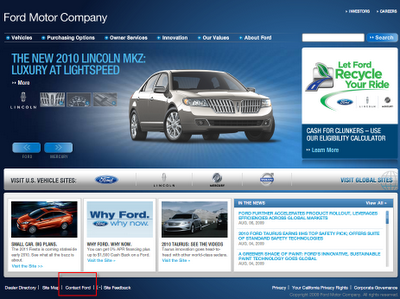 Wow, it took me 5 minutes just to find the "Contact Ford" link. It's at the very bottom left (see the red box above). Once you clicked on it you get this:
Wow, it took me 5 minutes just to find the "Contact Ford" link. It's at the very bottom left (see the red box above). Once you clicked on it you get this:
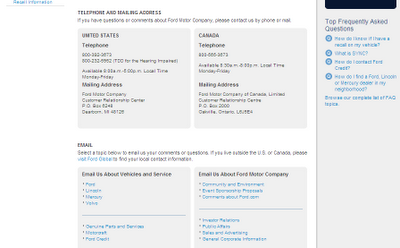 No lead capture signup form, not even a "Enter Your Email Address" box. Just a list of phone numbers and a few email links! A golden opportunity to collect new leads, completely wasted.
No lead capture signup form, not even a "Enter Your Email Address" box. Just a list of phone numbers and a few email links! A golden opportunity to collect new leads, completely wasted.
GM's Website:
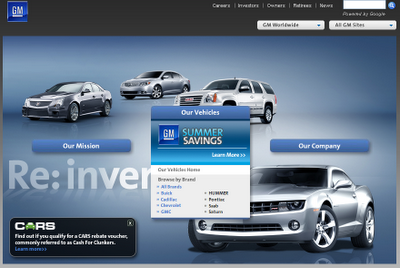 Wow, no "Sign Up Now" link whatsoever. Not even a "Contact Us" link.
Wow, no "Sign Up Now" link whatsoever. Not even a "Contact Us" link.
Nissan's Home Page:
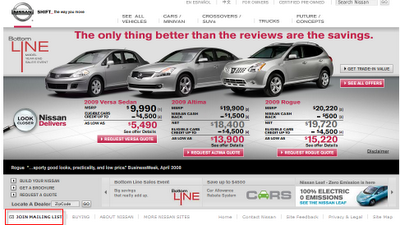 Ah, the first website that actually mentions the "Cash for Clunker" program. In fact they show the savings right up front! Still I had to dig to find the "Join Mailing List" link (see the red box at the bottom left).
Ah, the first website that actually mentions the "Cash for Clunker" program. In fact they show the savings right up front! Still I had to dig to find the "Join Mailing List" link (see the red box at the bottom left).
Once you click the link you get this:
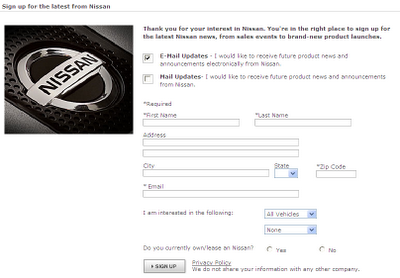 Ah, at last a lead capture form! Nice and short, not too many fields. A nice touch, asking whether I preferred direct mail and/or email. No segmentation however, other than choosing the model of car you are interested in, which is certainly better than nothing.
Ah, at last a lead capture form! Nice and short, not too many fields. A nice touch, asking whether I preferred direct mail and/or email. No segmentation however, other than choosing the model of car you are interested in, which is certainly better than nothing.
Toyota's Home Page
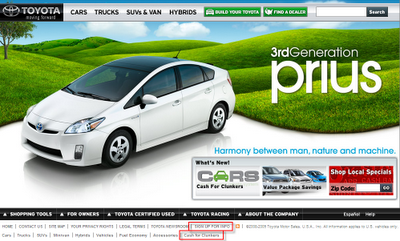
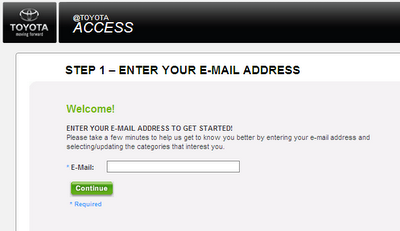
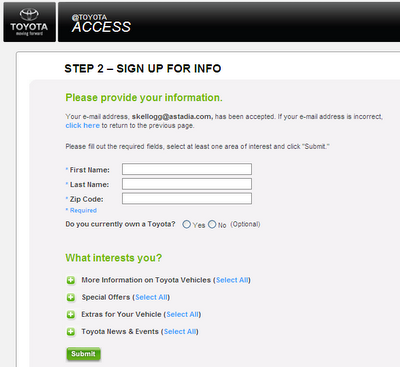
It is! The farm is saved. An actual subscription preference center. And they actually ask me, "What Interests You?" (Quick, somebody hand me a tissue).
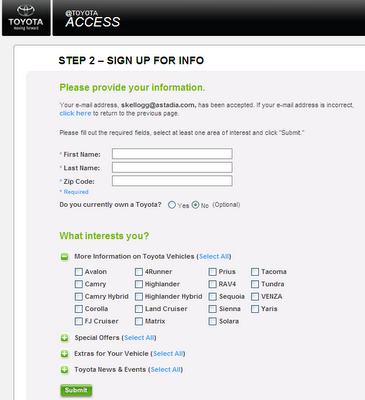
The page expands to see all the model choices! Here's what the full page looks like if you expanded all the questions:
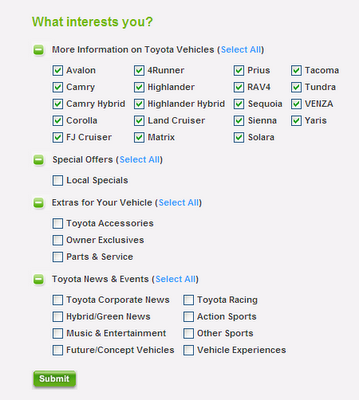
A great example of segmentation - and not overwelming you with choices until you ask to see them! Sniff, sniff, and you wonder why Toyota is #1...
Audi's Home Page:
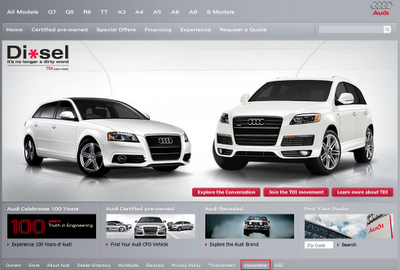

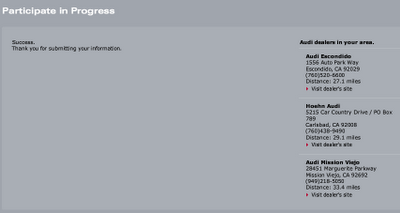
Audi was kind enough to show me the 3 closest dealers in my area. And I didn't even have to ask, sniff, sniff.
Mercedes Benz Home Page:
The first time I've seen this, a "Receive Updates" link - big, bold and beautiful, in the upper right hand corner!
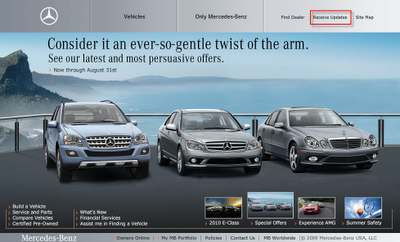 One wierd thing -- when you click the link, a blank box appears with a SUBMIT button next to it (see screenshot below).
One wierd thing -- when you click the link, a blank box appears with a SUBMIT button next to it (see screenshot below).
Do they think I am the Amazing Kreskin? What am I supposed to fill in here? So I typed in, "What am I supposed to fill in here?" and clicked Submit. I got a nice little error that said, "Submit a valid email address".
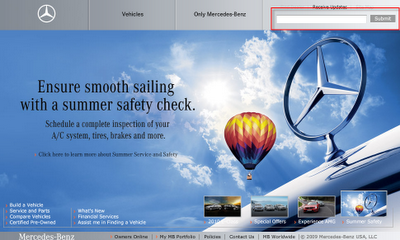 When you click on it, you get this:
When you click on it, you get this:
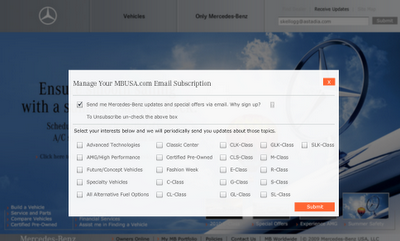
Ah, another subscription preference center. Not as thoughtful as Toyota's but still, not bad. Extra kudos for having the home page link actually noticable (even though they assume you'll know what to insert).
Porsche's Home Page:
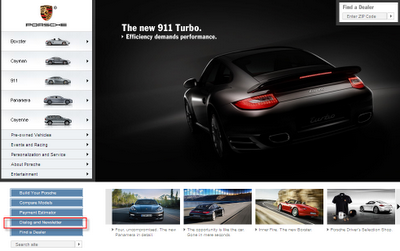
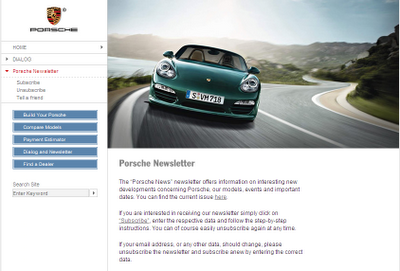
Once again, I am tasked with emulating the Amazing Kreskin in figuring out what to do next. Do you see a form anywhere? Do you see a clear CTA anywhere?
I am expected to actually read the instructions apparently. Clearly Porcshe does not care whether I sign up or not. (Maybe they somehow know that I already own one. That must be it).
Conclusion:
Steve Kellogg
On Twitter? Tweet this Post
I thought it would be fun to visit the home pages of Ford, Toyota, GM, Nissan, etc and see how each was taking advantage of the huge uplift in web traffic that all this buzz is generating. What a golden opportunity to capture net new leads into their databases for distribution to their dealers! So how is everyone doing?
Ford's Home Page:
 Wow, it took me 5 minutes just to find the "Contact Ford" link. It's at the very bottom left (see the red box above). Once you clicked on it you get this:
Wow, it took me 5 minutes just to find the "Contact Ford" link. It's at the very bottom left (see the red box above). Once you clicked on it you get this:  No lead capture signup form, not even a "Enter Your Email Address" box. Just a list of phone numbers and a few email links! A golden opportunity to collect new leads, completely wasted.
No lead capture signup form, not even a "Enter Your Email Address" box. Just a list of phone numbers and a few email links! A golden opportunity to collect new leads, completely wasted.GM's Website:
 Wow, no "Sign Up Now" link whatsoever. Not even a "Contact Us" link.
Wow, no "Sign Up Now" link whatsoever. Not even a "Contact Us" link.Nissan's Home Page:
 Ah, the first website that actually mentions the "Cash for Clunker" program. In fact they show the savings right up front! Still I had to dig to find the "Join Mailing List" link (see the red box at the bottom left).
Ah, the first website that actually mentions the "Cash for Clunker" program. In fact they show the savings right up front! Still I had to dig to find the "Join Mailing List" link (see the red box at the bottom left).Once you click the link you get this:
 Ah, at last a lead capture form! Nice and short, not too many fields. A nice touch, asking whether I preferred direct mail and/or email. No segmentation however, other than choosing the model of car you are interested in, which is certainly better than nothing.
Ah, at last a lead capture form! Nice and short, not too many fields. A nice touch, asking whether I preferred direct mail and/or email. No segmentation however, other than choosing the model of car you are interested in, which is certainly better than nothing.Toyota's Home Page

The "Sign Up for Info" link is still hard to find (see red box bottom middle). They also have a small "Cash for Cars" link. When you click the "Sign Up for Info" link, you get this:

Now we're talkin! A clean simple email address field! Be still my heart, could this possibly be a Progressive sign-up form?

It is! The farm is saved. An actual subscription preference center. And they actually ask me, "What Interests You?" (Quick, somebody hand me a tissue).
They even took usability a step further. They keep the page nice and clean. Then if you choose "More information on Toyota Vehicles" for example, thanks to some lovely javascript, you see this:

The page expands to see all the model choices! Here's what the full page looks like if you expanded all the questions:

A great example of segmentation - and not overwelming you with choices until you ask to see them! Sniff, sniff, and you wonder why Toyota is #1...
Audi's Home Page:

Once again, a tiny "Contact Us" link. Once you click on it you get this:

Nice clean web to lead form. Not as advanced as Toyota's however. After clicking submit you get this:

Audi was kind enough to show me the 3 closest dealers in my area. And I didn't even have to ask, sniff, sniff.
Mercedes Benz Home Page:
The first time I've seen this, a "Receive Updates" link - big, bold and beautiful, in the upper right hand corner!
 One wierd thing -- when you click the link, a blank box appears with a SUBMIT button next to it (see screenshot below).
One wierd thing -- when you click the link, a blank box appears with a SUBMIT button next to it (see screenshot below). Do they think I am the Amazing Kreskin? What am I supposed to fill in here? So I typed in, "What am I supposed to fill in here?" and clicked Submit. I got a nice little error that said, "Submit a valid email address".
 When you click on it, you get this:
When you click on it, you get this: 
Ah, another subscription preference center. Not as thoughtful as Toyota's but still, not bad. Extra kudos for having the home page link actually noticable (even though they assume you'll know what to insert).
Porsche's Home Page:

It didn't take me too long to find this link: "Dialog and Newsletter".
Just the sound of this link makes me want to yawn. Have you ever seen a more boring and emotionless CTA? I'm a sports car fanatic for God's sake! At least make it sound exciting for me to sign up! Or at least change it to "Signup or Not, Whatever".
Once you click the link, you get this:
Just the sound of this link makes me want to yawn. Have you ever seen a more boring and emotionless CTA? I'm a sports car fanatic for God's sake! At least make it sound exciting for me to sign up! Or at least change it to "Signup or Not, Whatever".
Once you click the link, you get this:

Once again, I am tasked with emulating the Amazing Kreskin in figuring out what to do next. Do you see a form anywhere? Do you see a clear CTA anywhere?
I am expected to actually read the instructions apparently. Clearly Porcshe does not care whether I sign up or not. (Maybe they somehow know that I already own one. That must be it).
Conclusion:
Yes, I know this is B2C. And clearly car makers all share a similar model of driving business to their dealers, not gathering leads for themselves.
Still, you can't buy the kind of media attention Cash for Clunkers is generating. Even if one has no insterest in buying a car, I'm sure there are many, many people browsing their favorite car maker's website just to see what all the hubbub is about. And at some point they will need a new car. A golden opportunity to collect valuable future leads. Some do it better than others as we've seen.
Be Ready
Still, you can't buy the kind of media attention Cash for Clunkers is generating. Even if one has no insterest in buying a car, I'm sure there are many, many people browsing their favorite car maker's website just to see what all the hubbub is about. And at some point they will need a new car. A golden opportunity to collect valuable future leads. Some do it better than others as we've seen.
Be Ready
If you are lucky enough to have the media focused on an event that effects your industry, jump all over it. Have your sign-up form link prominently placed on your home page. Be prepared to leverage all this free attention better than any of your competitors.
What You Can Do Now
What You Can Do Now
Insepct your competitor's websites and see how they manage subscription sign ups. Are they Porsche or are they Toyota? It is fairly easy to tell just how advanced their marketing is simply by inspecting the level of segmentation they ask for up front. If you are better at it, keep going, get even better! If you are worse at it than your competitors, well,,,you know what to do.
Updated 5-8-12
Visit my brand new website and learn more about Website Optimization Best Practices
Updated 5-8-12
Visit my brand new website and learn more about Website Optimization Best Practices
Steve Kellogg
-Demand Generation/Marketing Automation Consultant, Astadia
-Eloqua Certified Marketing Best Practices Consultant
On Twitter? Tweet this Post
Saturday, August 1, 2009
For Those Still Using Batch & Blast

Marketers should be revered. Seriously, marketing departments should all ask that red carpeting be installed in their offices immediately. I’m sure you could make the same argument for sales as well, but look what marketers have to deal with today.
· Email open rates down
· Email click-thru rates down
· Email deliverability rates down
· Diminishing returns from online advertising
· Diminishing returns from offline advertising
· Increased accountability for all ROMI spend
· Reduced budgets
· Reduced staff
· Increased demand for net-new leads
· Increased demand for qualified leads
And don’t put away your violins just yet, because in addition to all the above, our bosses now expect us to be social media experts, marketing automation experts, lead scoring experts, lead nurturing experts, segmentation experts, database experts, web analytics experts, even CRM experts, all while asking us to make do with less than we had before.
But before you decide to chuck it all and sell Amway instead, fear not – there is a solution!
The pain you are feeling is most likely because you are trying to leverage old marketing tools in the new economy. The fact that any Tom, Dick and Harry can now Batch & Blast thousands of emails from the comfort of their own bedroom, all for only $24.95/month, means that the final nail has been hammered into the coffin of Batch & Blast marketing. It is officially the end of an era.
Step 1: Retire Your Current Batch and Blast toolThrow a farewell party. It’s been a good ride and it got you to where you are. But realize that Batch & Blast was easy. That’s why everyone did it. The new economy requires more evolved tools and more evolved thinking. It will be harder than Batch & Blast – then actually easier as you gain momentum.
Step 2: Understand the Marketing Tools You Now Need
Today’s economy requires (yes requires) the following new marketing tools to get your messages through all the clutter. It’s a brave new world so make sure your marketing toolbox includes ALL of the following:
Tool #1: SegmentationCutting smaller and smaller pieces of your database into smaller and smaller segments is critical. In fact it is the next rung up your Marketing Evolution ladder from Batch & Blast: Segmentation.
Batch and Blast meant one-message-to-everybody. Segmentation now means having different conversations with different groups. The more defined the group, the more relevant your message. And relevancy drives success in the new economy. That’s why it is first on this list – because it will produce by far the biggest bang for your buck. Make sure your segmentation tool can handle requests like this:
“Show me a list of all IT Managers in our database that work for companies with at least 500 employees and annual revenues of at least 100m, who have opened at least one email from us in the last 30 days, have visited our website at least twice in the last 60 days and have downloaded a free trial with the last 7 days.”
BTW: This list shouldn’t take more than about 5 minutes to generate.
Tool #2: Marketing Automation
Can you imagine trying to manually manage different conversations with all these different segments? Especially with reduced budgets and reduced staff? Your segmentation efforts will be severely limited. Marketing automation is what makes segmentation truly scalable. It is also what gets you to the next rung on your Marketing Evolution Ladder – One to One Marketing (messaging driven by: because you did this, you now get this). Let the low cost and high efficiencies of marketing automation handle things like:
· Relationship-building Nurturing Programs
· Welcome/Onboarding Programs
· Subscription Renewal Programs
· Upsell/Cross Sell Promotions
Tool #3: Lead Management/Scoring
One of the biggest complaints sales has with marketing-generated leads is that they are not qualified. Typically the flow goes like this: (1) Marketing generates a fresh batch of leads and sends them to sales, (2) sales cherry picks the good leads and (3) the rest leak out of the funnel. (4) Marketing generates a new batch of fresh leads and…(see #2). The endless lead-loop scenario.
This is where marketers should show a little love to poor salespeople. Why send ALL leads to sales and make them waste their valuable time qualifying everybody when marketing can now leverage nurturing/scoring, sending over ONLY qualified leads at the precise moment they are worthy of sales interaction.
Sales wins because they now have a priority list of who to call first, second, third. Marketing wins because their hard-fought leads won’t get ignored anymore just because they aren’t ready to buy this minute.
Tool #4: Closed-Loop ReportingNo matter what, your boss will expect quantifiable results from this new tool. Both you and your boss will want to know things like:
· How much additional revenue did our nurturing/scoring program generate last quarter?
· What was the percentage increase of our subscription renewals since implementing these automated programs?
· Which campaign(s) were the most effective at reducing the sales cycle?
· Which campaign(s) were the most effective at increasing the average revenue per deal?
· Which segment had the highest ROI growth?
· Which segment within the above segment produced the highest ROI growth? Are these our new best customers?
· How much additional revenue was generated from our ‘inactive’ database as a result of our re-engagement automation program?
· Which of our assets (case studies, white papers, etc) produced the highest opportunity to close rate last quarter?
While your new marketing toolbox will tell you the I in ROI, you’ll need a true CRM integration to tell you the R in ROI. For this reason it is important that your new marketing toolbox be able to fully integrate with your CRM. The more automated the integration, the better.
Tool #5: Get a GPS (Warning – Sales Pitch Ahead)
Those of us who have a GPS have come to completely rely on them. So why would you ever start down this road without a clear roadmap?
· Email open rates down
· Email click-thru rates down
· Email deliverability rates down
· Diminishing returns from online advertising
· Diminishing returns from offline advertising
· Increased accountability for all ROMI spend
· Reduced budgets
· Reduced staff
· Increased demand for net-new leads
· Increased demand for qualified leads
And don’t put away your violins just yet, because in addition to all the above, our bosses now expect us to be social media experts, marketing automation experts, lead scoring experts, lead nurturing experts, segmentation experts, database experts, web analytics experts, even CRM experts, all while asking us to make do with less than we had before.
But before you decide to chuck it all and sell Amway instead, fear not – there is a solution!
The pain you are feeling is most likely because you are trying to leverage old marketing tools in the new economy. The fact that any Tom, Dick and Harry can now Batch & Blast thousands of emails from the comfort of their own bedroom, all for only $24.95/month, means that the final nail has been hammered into the coffin of Batch & Blast marketing. It is officially the end of an era.
Step 1: Retire Your Current Batch and Blast toolThrow a farewell party. It’s been a good ride and it got you to where you are. But realize that Batch & Blast was easy. That’s why everyone did it. The new economy requires more evolved tools and more evolved thinking. It will be harder than Batch & Blast – then actually easier as you gain momentum.
Step 2: Understand the Marketing Tools You Now Need
Today’s economy requires (yes requires) the following new marketing tools to get your messages through all the clutter. It’s a brave new world so make sure your marketing toolbox includes ALL of the following:
Tool #1: SegmentationCutting smaller and smaller pieces of your database into smaller and smaller segments is critical. In fact it is the next rung up your Marketing Evolution ladder from Batch & Blast: Segmentation.
Batch and Blast meant one-message-to-everybody. Segmentation now means having different conversations with different groups. The more defined the group, the more relevant your message. And relevancy drives success in the new economy. That’s why it is first on this list – because it will produce by far the biggest bang for your buck. Make sure your segmentation tool can handle requests like this:
“Show me a list of all IT Managers in our database that work for companies with at least 500 employees and annual revenues of at least 100m, who have opened at least one email from us in the last 30 days, have visited our website at least twice in the last 60 days and have downloaded a free trial with the last 7 days.”
BTW: This list shouldn’t take more than about 5 minutes to generate.
Tool #2: Marketing Automation
Can you imagine trying to manually manage different conversations with all these different segments? Especially with reduced budgets and reduced staff? Your segmentation efforts will be severely limited. Marketing automation is what makes segmentation truly scalable. It is also what gets you to the next rung on your Marketing Evolution Ladder – One to One Marketing (messaging driven by: because you did this, you now get this). Let the low cost and high efficiencies of marketing automation handle things like:
· Relationship-building Nurturing Programs
· Welcome/Onboarding Programs
· Subscription Renewal Programs
· Upsell/Cross Sell Promotions
Tool #3: Lead Management/Scoring
One of the biggest complaints sales has with marketing-generated leads is that they are not qualified. Typically the flow goes like this: (1) Marketing generates a fresh batch of leads and sends them to sales, (2) sales cherry picks the good leads and (3) the rest leak out of the funnel. (4) Marketing generates a new batch of fresh leads and…(see #2). The endless lead-loop scenario.
This is where marketers should show a little love to poor salespeople. Why send ALL leads to sales and make them waste their valuable time qualifying everybody when marketing can now leverage nurturing/scoring, sending over ONLY qualified leads at the precise moment they are worthy of sales interaction.
Sales wins because they now have a priority list of who to call first, second, third. Marketing wins because their hard-fought leads won’t get ignored anymore just because they aren’t ready to buy this minute.
Tool #4: Closed-Loop ReportingNo matter what, your boss will expect quantifiable results from this new tool. Both you and your boss will want to know things like:
· How much additional revenue did our nurturing/scoring program generate last quarter?
· What was the percentage increase of our subscription renewals since implementing these automated programs?
· Which campaign(s) were the most effective at reducing the sales cycle?
· Which campaign(s) were the most effective at increasing the average revenue per deal?
· Which segment had the highest ROI growth?
· Which segment within the above segment produced the highest ROI growth? Are these our new best customers?
· How much additional revenue was generated from our ‘inactive’ database as a result of our re-engagement automation program?
· Which of our assets (case studies, white papers, etc) produced the highest opportunity to close rate last quarter?
While your new marketing toolbox will tell you the I in ROI, you’ll need a true CRM integration to tell you the R in ROI. For this reason it is important that your new marketing toolbox be able to fully integrate with your CRM. The more automated the integration, the better.
Tool #5: Get a GPS (Warning – Sales Pitch Ahead)
Those of us who have a GPS have come to completely rely on them. So why would you ever start down this road without a clear roadmap?
Astadia is Eloqua’s #1 deployable partner as well as SFDC’s #1 deployable partner. Astadia has over 200 sales specialists and marketing specialists that can help you completely architect and integrate your whole sales and marketing transformation. They know the bottlenecks, the shortcuts, the detours, in short the fastest route in getting everything working. Armed with the experience of helping Best in Class companies around the world, there aren't many sales and marketing transformation challenges they haven’t faced and solved before.
Updated 5-8-12
Visit my brand new website and learn more about Marketing Automation Best Practices
Steve Kellogg
-Demand Generation/Marketing Automation Consultant, Astadia
-Eloqua Certified Marketing Best Practices Consultant
-Demand Generation/Marketing Automation Consultant, Astadia
-Eloqua Certified Marketing Best Practices Consultant
On Twitter? Tweet this Post
Saturday, July 25, 2009
No More Horizontal Scrolling
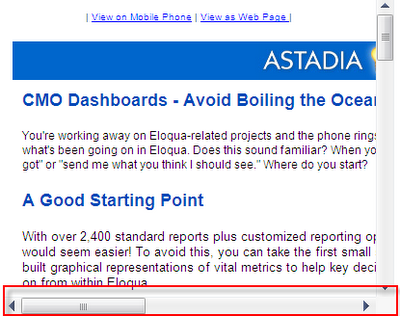
Forcing viewers to have to scroll horizontally just to see all your message is just not right.
Wouldn’t it be great if you could design your emails to automatically scale to whatever width the end user has available in their preview pane, no matter how wide or narrow it is – even on mobile phones?
Usually the width of most emails is dictated by the width of the header image. If the header image is 600px wide, then the email must be 600px wide as well. WARNING: Horizontal Scrolling Alert!
Usually the width of most emails is dictated by the width of the header image. If the header image is 600px wide, then the email must be 600px wide as well. WARNING: Horizontal Scrolling Alert!
The challenge is that we really don't know what any given viewer's available width really is. It could be 350px wide, it could be 550px wide, etc. depending on how their email window is set up.
So let's forget about pixels altogether and instead make the width a percentage instead.
100% = means that the email will scale to 100% of the available width
90% = the email will scale to 90% of the available width – great if you want a bit of white space on the left and right side
80% = the email will scale to 80% of the available width – great if you want even more white space on the left and right side
Etc.
90% = the email will scale to 90% of the available width – great if you want a bit of white space on the left and right side
80% = the email will scale to 80% of the available width – great if you want even more white space on the left and right side
Etc.
So does this mean that your header image will automatically scale 100%? Alas no. If your header image is 600px and the available viewing width is 700px then the email will expand wider than the header image. But if the available viewing area is only 500px, then the email has to expand to at least 600px to accommodate the header (we’re back to our original problem).
The trick to getting this to work is to make the header image small enough that there is no horizontal scrolling on any device, even mobile devices. This means your header can’t be any wider than about 320px.
The trick to getting this to work is to make the header image small enough that there is no horizontal scrolling on any device, even mobile devices. This means your header can’t be any wider than about 320px.
Filling the Gaps
Obvioulsy a 320px header might loook pretty stupid if there are big gaps to the left and right. One solution to fill the gap is what we at Astadia use. The actual header image is only 320px but we added a blue background color within the image itself that appears to span the whole width of the email.
In fact the blue to the left and right of the image is not an image at all, but just a color fill to match the blue in the background of our image.
Now it looks like a blue colored header with the logo image in the middle.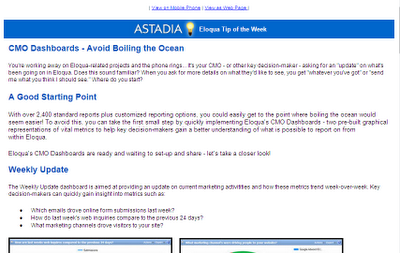
How to do it
Now it looks like a blue colored header with the logo image in the middle.

How to do it
Step 1: Create a 2-column table (set the width to 100%)
 Step 2: Insert the header image inside the left colum and right-justify it
Step 2: Insert the header image inside the left colum and right-justify it Step 3: Add a background color to the left column that matches the background color of your header
Step 3: Add a background color to the left column that matches the background color of your header Step 4: Add the same background color to the right column
Step 4: Add the same background color to the right column Step 5: Add some white text to the right column and make sure to left-justify it
Step 5: Add some white text to the right column and make sure to left-justify it Now, no matter how wide or narrow the window is, the email always fills 100% of the space - with no horizontal scrolling! And the header always looks nice and centered!
Now, no matter how wide or narrow the window is, the email always fills 100% of the space - with no horizontal scrolling! And the header always looks nice and centered!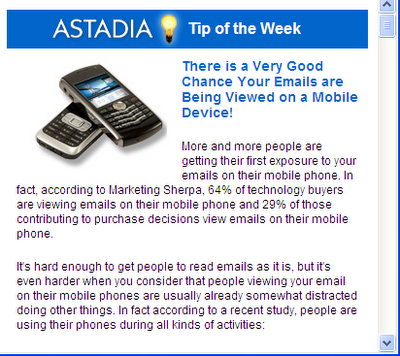
320px wide
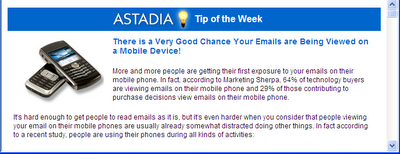
600px wide
BTW: This was taken from an Astadia Tip of the Week I wrote called, Designing Emails for Mobile Devices. If you are not signed up to receive these free weekly tips, contributed by the entire Astadia-Eloqua team, sign up now!
Steve Kellogg
-Demand Generation/Marketing Automation Consultant, Astadia
-Eloqua Certified Marketing Best Practices Consultant
-Demand Generation/Marketing Automation Consultant, Astadia
-Eloqua Certified Marketing Best Practices Consultant
Subscribe to:
Comments (Atom)




